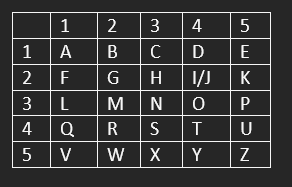A Beginner's Guide to Cipher Solving
written by Vivian Murphy
Solving Ciphers: Caesar, Polybius, and Vigenere
So, you've solved your first cipher! I hope my tips helped. Now, let's move on to something different, and a bit more complicated. The Polybius square takes a bit longer to set up, but has tougher encryption, and also has a much more complex key, an unmodified version of which exists below. It is mostly attributed to whom bears its name, Polybius, a Greek historian, and uses numbers to encrypt text.
The coordinates (x, y) of each letter in the square form its numeration in ciphertext, for example, A would become 11. Letters may then be separated by dashes, so hoof would become 32-43-43-12. The English alphabet, with 26 letters, has one more than the square likes, so I and J are combined into one coordinate, which may make things a bit more difficult when solving. Various key phrases may dictate how a square can be encrypted, such as 'The qick bwn fx umps ovr lazy dg.' There are also different ways to use an unencrypted Polybius square, such as putting the vertical coordinate first (easy to trip someone up!) or using it in conjunction with a Caesar cipher.
Decrypting with a key is simple, as you read the coordinates on a square to turn it back into letters. When it comes to decrypting a Polybius square without a key, it can be quite difficult to brute force, similar to how you were able to do with the Caesar cipher. You'll likely need a hint of some kind of clue in order to solve the cipher. When you come across one, think about codes or phrases that might surround the ciphertext in plaintext, if any are available.
Your move, dear reader. To solve without losing your sanity, I recommend that you find some sort of hint that might have been placed around, and translate that key phrase into a Polybius square. I also used proper punctuation and capitalization, too.